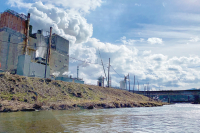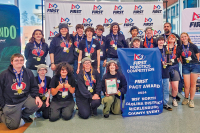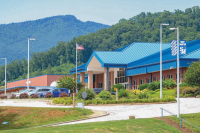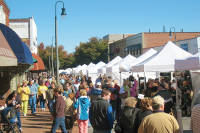The great routing debate: North Carolina’s battle for the Parkway
To mountain communities, the coming of the Blue Ridge Parkway 75 years ago was seen as economic salvation.
It would provided much-needed construction jobs to a region ravaged by the Depression and ultimately bring a parade of tourists seeking natural scenery.
The Parkway symbolized America’s newfound love affair with the automobile, increasingly accessible to the
middle-class yet still a novelty.
“The Parkway was conceived very much in the vein that the car would be a pleasure vehicle,” said Ted Coyle, an anthropologist at Western Carolina University. “When the Parkway was built, no one had the idea that you would take your car to go shopping. Cars were to go out and take scenic drives with.”
Today, the Parkway seems intrinsic to the mountains and carries a sense of entitlement to the millions of locals and tourists who enjoy it annually.
Related Items
“It makes us feel like the Parkway was inevitable somehow, that someone thought it up wholesale, saw the
mountains and put it right out there on the land,” said Anne Whisnant, a leading Parkway historian and author at the University of North Carolina at Chapel Hill.
But the Parkway could easily have been something quite different. It was beset by social and political battles, which shaped and reshaped its route through the landscape from its conception in the early 1930s until
its eventual completion in 1987.
No sooner had President Roosevelt endorsed the Blue Ridge Parkway under the New Deal in 1933 than a raging debate broke out between North Carolina and Tennessee about which state would win the Parkway.
It had but one parameter at first: connect Shenandoah National Park with the Great Smoky Mountains. Designers soon crafted a route that would send the Parkway veering out of North Carolina and into Tennessee around Grandfather Mountain, bypassing the established tourist magnate of Asheville entirely and bringing traffic to the Smokies via Tennessee’s doorstep.
Asheville business leaders and politicians were distraught. The Depression had brought the city to its knees, and Asheville leaders saw the Parkway as a life or death proposition.
“If the Parkway were diverted from Asheville, it seemed the situation would be entirely and permanently hopeless,” Whisnant said. “The state of North Carolina got busy writing Tennessee out of the picture.”
Asheville politicians and business leaders mounted a masterful campaign to reroute the road past their city, enlisting far reaching support from the local tourist industry to the state house and governor’s mansion.
North Carolina “flung down the gauntlet” in its bid to cut Tennessee out and the “battle for the Parkway was on,” Fred Weede, director of the Asheville Chamber of Commerce at the time, wrote in his personal account of the year-long fight. Giving the Parkway to Tennessee would be an “appalling disaster,” Weede wrote in his retrospective.
The North Carolina contingency argued that God anointed them with better scenery and higher mountains. To put the Parkway anywhere else would be an affront to the Creator. But they realized that alone would not be enough to prevail.
“God had given us better scenery but man’s strategy and energy had to win the Parkway,” Weede wrote. “There were numerous tight spots encountered in shaping up a unified front. Iron hands were sometimes necessary.”
Masterful campaign
North Carolina’s campaign would not be an easy one. President Roosevelt had already endorsed the three-state route for the Parkway in a proclamation from the summer of 1933. Tennessee was well-established as the primary gateway to the Great Smoky Mountains National Park with park headquarters located there.
The Bureau of Public Roads, which would oversee eventual construction, also preferred the Tennessee route. The mountains around Asheville were the steepest and highest in the Appalachian chain, and building a road across them was seen as too expensive and challenging.
Even the landscape architects tasked with the Parkway’s design favored the lower-lying Tennessee route to provide a diversity of scenery, rather than subjecting travelers to mile upon mile of scenic but repetitive high-elevation peaks.
In an early strategy meeting held at the Asheville Chamber of Commerce, Weede impressed on the gathering the enormity of their attempt to turn the tide.
“I asserted we should face the fact we were licked before we began. But as dedicated citizens we should roll up our sleeves and fight,” Weede recounted.
Under mounting pressure from the North Carolina delegation to at least consider its pleas, Department of Interior Secretary Harold Ickes appointed a special committee tasked with selecting a route. The two states squared off in a public showdown before that committee in February 1934. In the hearing, the dueling states had three hours to present their cases.
North Carolina arrived with a well-orchestrated pitch, including large maps and photos of the “best” route for the Parkway. While several speakers made remarks, the bulk of the presentation was deferred to Getty Browning, a top road engineer with the N.C. Highway Commission, who had emerged as an effective point man for the North Carolina route.
Realizing the hue and cry from Asheville business leaders would do little to bend the committee’s ear, Browning instead focused on what he considered more objective reasoning: the superior scenery of the high mountains around Asheville.
As a locating engineer, Browning often set out cross-country on foot, climbing rugged mountains in search of the most ideal highway routes and had personally blazed every mile of the Parkway corridor North Carolina was proposing.
“He was the man on the ground in the literal sense,” said Houck Medford, director of the Blue Ridge Parkway Foundation. “He walked the Blue Ridge Parkway boundary an untold number of times. He was certainly a man’s man, but he had these other attributes and qualities that made him successful.”
He was a well-heeled socialite — charismatic, persuasive and politically savvy — yet with the mind of an engineer and persona of an outdoorsman.
Throughout the hard-fought crusade fraught with political wars and the feuding business interests, Browning kept his sights fixed on true purpose behind the Parkway.
“For Browning, it was ultimately about letting other people see the beauty of the mountains the way he saw it. There is something noble in that,” Whisnant said. “It would be useable by everyone. It would be available for free. It wouldn’t be overly controlled by commercial or monetary influences. It had something to do with our spirit.”
Following the hearing, the committee decided to take a tour of the North Carolina route. A caravan of 15 cars left Washington in March. The traveling party included many of the key players within with the National Park Service, Department of Interior and Bureau of Public Roads who would later shepherd the Parkway’s design and construction.
Since no good roads existed along much of the proposed route for the Parkway, the party planned to take side roads up and down the mountains to get a feel for the general terrain where the Parkway might pass. But the traveling party encountered a major snowstorm after crossing into North Carolina. Some gave up on the expedition in Blowing Rock. Those who ventured on to Asheville through the snow, ice and fog quite nearly didn’t make it. They later resorted to viewing the routes from the air.
Refining a strategy
As the summer of 1934 dragged on, the North Carolina contingency grew anxious. The committee tasked with recommending a route was mum.
The strategists didn’t let the downtime go to waste, however. They constantly refined their arguments and enlisted new messengers to lobby on their behalf in Washington. They met often to plan and carry out a campaign Weede later described as a “mosaic.”
“Road blocks, and they were plentiful, were approached from all angles and various solutions were weighed,” Weede wrote. “Between us — even if otherwise disposed — all cards had to put on the table face up.”
They heralded the already developed tourist industry in Asheville, ready and able to provide Parkway travelers with the type of amenities they would expect, compared to the more industrial nature of Knoxville.
They also pointed out the dearth of New Deal spending in their state. Tennessee was meanwhile the recipient of huge federal investments from the massive network of hydroelectric dams being construction by the Tennessee Valley Authority.
Newspapers played an integral role as well. The publisher of the Asheville Citizen, Charles Webb, brought the full force of his newsprint to bear for the campaign and convinced newspapers elsewhere in the state to follow his lead.
The strategists left no stone unturned, even throwing an extravagant dinner in honor of the wife of the Secretary of Interior at the Grove Park Inn when she visited Asheville.
But the centerpiece of the campaign came in the form of a red, Moroccan-leather bound photo album with a gold engraving of Roosevelt on the cover to be hand delivered to the President by an Asheville contingency. The photos showcased the scenery of the mountains around Asheville — scenery that would be left out by a Tennessee route.
The photos were culled from the collection of George Masa, a famous Japanese photographer who documented landscape scenes in Western North Carolina, while others were shot by a paid photographer escorted by Browning for the sole purpose of the project.
While much of the campaign was mounted on a shoestring due to the Depression, the nearly bankrupt Asheville Chamber of Commerce funded the production of the album, which included an inside pocket with a hand-drawn relief map of their favored route and artfully-lettered titles over each photo.
Final showdown
With still no word from the committee, Secretary of Interior Ickes announced that he would personally preside over a final hearing before selecting the route in September 1934.
A testament to the sophisticated campaign by the North Carolina delegation, a strategy was mounted to pack the hearing with their own supporters. A special train was chartered to carry their entourage to Washington. It was 18 Pullman cars long when it left Asheville with more tacked on as it traveled across the state, including a car for the governor.
A memo was read out to every car on the train instructing them to show up early for the hearing the next day. When the appointed hour arrived, nearly every chair in the room was filled by the North Carolina delegation, relegating Tennessee to standing room and the hallway outside.
Throughout the summer, Browning had bolstered his engineering case in preparation for such a final hearing, including large mounted photos offering a visual tour of the preferred route. The presentation wholly dwarfed that put on by Tennessee.
But unbeknownst to North Carolina, their opponent had an ace up its sleeve. Earlier that morning, the committee tasked with recommending a route had finally issued its decision: It unanimously favored the Tennessee route. The report was leaked to Tennessee and, although Ickes had likewise received a copy that morning, Tennessee’s delegation proudly flaunted it during the hearing.
“The announcement was a bombshell for us,” Weede wrote. “We looked at each other with considerable consternation. It was no light matter.”
To side with North Carolina, Ickes would have to rebuff his own committee.
But North Carolina had an ace of its own — one known to only a handful of key players within the campaign. It wasn’t revealed for nearly two decades and still remains a largely unknown turning point in the great routing debate.
“This ace was a very hush-hush move. No more than half a dozen individuals were in on the secret,” Weede wrote.
North Carolina’s clandestine trump card was a man named Josephus Daniels, a newspaper tycoon in the state with a summer home at Lake Junaluska near Waynesville, N.C., a town west of Asheville.
Daniels, a supporter of the North Carolina route, had personal connections that reached straight to the top. He served as the Secretary of the Navy during WWI, and his assistant secretary and right-hand man was none other than Roosevelt. Daniels was friends with Ickes to boot.
Daniels was reluctant to exploit his personal friendship with Roosevelt and Ickes, however, and throughout the agonizing spring and summer of 1934, Daniels refused to pull that lever.
“How to get him to move was our big problem,” Weede recounted.
One summer evening, Weede and Charles Webb, the publisher of the Asheville Citizen, and two other compatriots set out from Asheville to Lake Junaluska to confront what Weede called “the Daniels’ problem” head on. They arrived on the porch of Daniels’ summer home to find him already chatting with none other than Getty Browning. Daniels had clear moral objections to what the men were asking.
“Indeed our own consciences had to be stifled in urging a man to lay aside his lofty and sincere ideals of propriety and the niceties of friendship and perform an act to aid his state in its rugged battle for a great project,” Weede wrote. “It was no easy task to out argue him. But we were four against one. And we were sincere and desperate.”
They spent three hours lobbying Daniels on his porch that night, according to Weede’s account. But they left with the wording of a telegram Daniels scribbled on the back of an envelope asking Ickes for a meeting that Weede would wire the next morning.
Daniels met with both Ickes and Roosevelt that week and continued his conversations with Ickes leading up to the final showdown in September.
Two more months of waiting passed before Ickes made the announcement in November 1934 that the full route would go to North Carolina. Tennessee was livid and chastised Ickes for overruling his own advisory committee, and even appealed to Roosevelt to overturn the decision but to no avail.
The Last Front
With a route in hand, construction was imminent. But Browning’s general strokes on a map were a long way from being fixed on the landscape. The tug-of-war for the Parkway would now play out between villages and neighbors.
“You are going through a populated landscape with farms and communities. They all had different ideas about where the Parkway should go and what it should be,” Whisnant said.
While the federal government was putting up money for construction, buying rights of way fell to the states. The fabled road suddenly wasn’t so appealing to farmers along the proposed route who faced the reality of losing their land. Early descriptions of the Parkway called for a right of way of only 200 feet. But designers and engineers realized it must be five times that at least.
“If you are going to have a scenic parkway you have to preserve the scenery. They had to do that with a wide right of way,” Whisnant said. “That was a shock to landowners. It was much wider than a regular road.”
The rhetoric used when selling the Parkway wasn’t playing out like locals were led to believe. The great economic benefit seemed to evaporate with they found they couldn’t build roads and driveways from neighboring land onto the Parkway.
“Road building before that was always about giving people a way in and out,” Whisnant said.
Instead, the Parkway would have only a few appointed entrances. The Parkway was prone to trespassing and vandalism by disgruntled landowners along its length.
“A few said ‘I’m going to bulldoze a road from my property to the Parkway and there’s nothing you can do to stop me,’” Whisnant said. Others cut trees on Parkway right of way to purposely despoil roadside views.
Meanwhile, business interests were dismayed to learn they couldn’t put up billboards or signs along the route.
“It was supposed to benefit tourism but how is it going to benefit tourism if we can’t put up signs to direct people to our businesses?” Whisnant said of the sentiment. “This was sold to us as a tourism prospect but it is not.”
To make matters worse, the Parkway built its own diners and gas stations, a form of direct competition that gave tourists no compelling reason to exit the motorway.
There were also inevitable conflicts with landowners about the price being offered for rights of way. Some of the more admirable opponents were Hugh Morton of Grandfather Mountain and Harriet Clarkeson of Little Switzerland, two already developed tourism enterprises along the Parkway’s route north of Asheville. They not only understood the legal process but had political clout to take their case to the media.
Others simply lamented the passing of an era symbolized by the coming of the Parkway. Bill Watson, born in 1923, remembers when the Parkway came through the small community of Benge Gap near Boone, claiming part of his father’s farm and general store in 1938. His dad built a new one, but it wasn’t the same.
The Parkway brought rapid change to the barter-based economy that once played out inside the general store. Customers would haul in chestnuts, herbs, eggs, chickens, lumber, furs and even livestock to trade for goods from Watson’s father. Suddenly, Watson’s father found himself selling root beer to tourists.
“He much didn’t like it. He was used to being in a quiet place,” Watson said in an oral history preserved in the Parkway’s archives.
Watson moved away as a young man, but came back in the early ‘60s with a proposition for his father. He wanted to build a motel and restaurant in hopes of catering to Parkway tourists. His father was reluctant, but Watson eventually won out.
“He said that ‘Bill had lost his mind to spend his money on a motel and restaurant,’” Watson recounted. “Then so many people started coming in.”
And so it goes today. With nearly 17 million visitors every year, the Blue Ridge Parkway was indeed a prize worth fighting for.
“Certainly our forefathers, when they had the vision for the Parkway, were right on target,” said Lynn Minges, director of the N.C. Division of Tourism. “It has done exactly what they intended it to do.”









